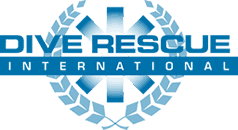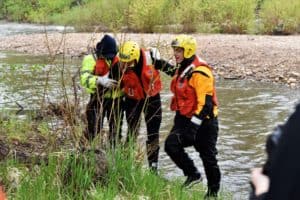Swiftwater Rescue II is Dive Rescue International’s advanced three day (24 hour) swiftwater training
program. All students are required to have basic swiftwater rescue skills including: excellent swimming
skills, operational experience using high-lines and a working knowledge of knots, rigging and mechanical
advantage systems. All students should be prepared for multiple challenging in-water scenarios.
Specific and detailed information will be provided regarding searching by using coordinated land and
water-based teams.
This program is presented in the classroom and open-water to allow students to become familiar with
different field scenarios and engage in team-building exercises. Successful completion of this program
is measured in class participation and a comprehensive test.
Key training topics and the associated objectives include:
CHARACTERISTICS OF MOVING WATER
Identify examples where fast moving water is moving in a linear direction (swiftwater)
Define the four river references as they relate to facing downstream
Describe the two types of flow associated with water moving through a river bed and the four
characteristics of water dynamics
THE HUMAN BODY IN WATER
Identify the factors effecting the buoyancy and descent of the human body in swiftwater including
current, body type, and clothing
Explain why the “sack of potatoes” myth does not work in tracking a victim’s pathway in swiftwater
Describe the factors that effect the physiology of body re-float
Identify victim considerations in reference to body re-float
Explain why some bodies will not re-float
SAFETY CONSIDERATIONS
Identify swiftwater hazards and their associated risks
Define the Risk/Benefit Analysis of an operation
List the following: personal protective equipment (PPE) for shore-based and in-water rescuers;
swiftwater team equipment; and search equipment
Discuss personal protective equipment for both shore-based and in-water rescuers
SCENE EVALUATION
Identify the factors that are assessed in a scene evaluation as well as other considerations that may
come up as information on the scene becomes available
Describe factors that are used in the process of determining the last-seen point (LSP)
Define reference point and reference object
Explain witness interview procedures and the establishment of a victim profile
Identify sketch components in a scene sketch and explain why documentation is important
ESTABLISHING OPERATIONAL OBJECTIVES
Define a rescue vs. recovery operation
Describe initial search objectives and ongoing search objectives
SEARCH TACTICS
Discuss what circumstances can vary that will change search tactics
Describe the considerations team leaders must make before fielding search teams
Explain perceptions and expectations when searching for a victim
Identify the steps taken to care for a victim’s body once it is located
Describe considerations taken for family and media once a body is found
KNOTS AND RIGGINGS
Identify the different anchor/riggings systems
List and describe the different types of knots and in what scenarios they would be used
Explain the tensioning of high line systems
PREREQUISITES
All students must be a current member of a public safety agency, at least 18 years of age and must show
proof of Swiftwater Rescue 1 certification.
This program is designed for personnel who are physically fit. Participants are encouraged to participate
after successfully completing the IADRS Watermanship Test or testing to a fitness level of 13 MET
(Metabolic Equivalents) or greater. Participants with aerobic fitness questions or concerns should consult
their physician prior to in-water training. Participants who have poor aerobic fitness may attend this program
as surface support personnel with the approval of the instructor.
BE SURE TO BRING
All students should bring: clothing appropriate for weather conditions, adequate footwear, watersports
helmet, and U.S. Coast Guard approved P.F.D. (Type III or V) with whistle and cutting tool, and pen and
paper. In-water participants must provide their own wetsuit or swiftwater dry suit, water rescue gloves, work
gloves and fins.
Swiftwater Rescue II
Course Outline
DAY 1
8:00-9:00 Program Introduction / Overview
Completion of class paperwork
9:00-12:00 Program Presentation
Written Exam
12:00-1:00 Lunch
1:00-2:30 Team Building Exercises
2:30-5:00 Skill Completion and Review
Knots and Throwbag Competition
Rigging
4-Line Boat Rigging
Highline Rigging Techniques
DAY 2
8:00-8:30 Introduction to Objectives
8:30-12:00 Field Exercises
River Reading – Areas of Probability
Skill Verification –
Float, Swim, & Swiftwater Rescue Board Exercises
Contact Rescues
Boat Operations Practice
Lunch on the go
12:00-5:00 Field Exercises
Search / Rescue Exercises
DAY 3
8:00-5:00 Advanced Swiftwater Rescue Scenarios
Advanced Scenarios
Lunch on the go
Advanced Scenarios (continued)
Final Critique
Closing



One Comment on “Swiftwater Rescue II in Twin Falls, Idaho now open for registration for May of 2022”
Looking for the registration packet for this class, any help would be great.